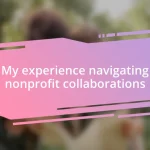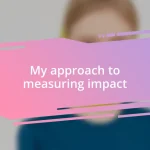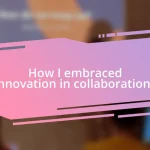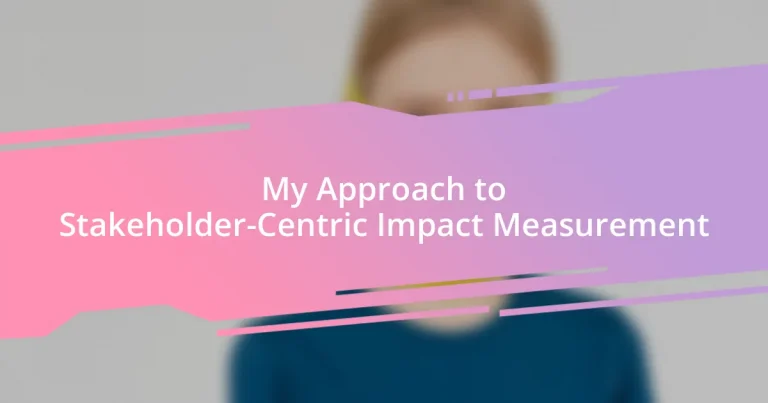Key takeaways:
- Stakeholder-centric measurement prioritizes the voices of those impacted, transforming project evaluations to reflect community insights and emotional connections.
- Engaging stakeholders fosters trust and ownership, ensuring that their input directly influences project outcomes and strategies.
- Defining impact metrics should be a collaborative process, blending quantitative and qualitative insights to reflect stakeholders’ true needs and aspirations.
- Effective communication of impact involves relatable storytelling, transparency about challenges, and the use of visuals to enhance understanding and engagement.
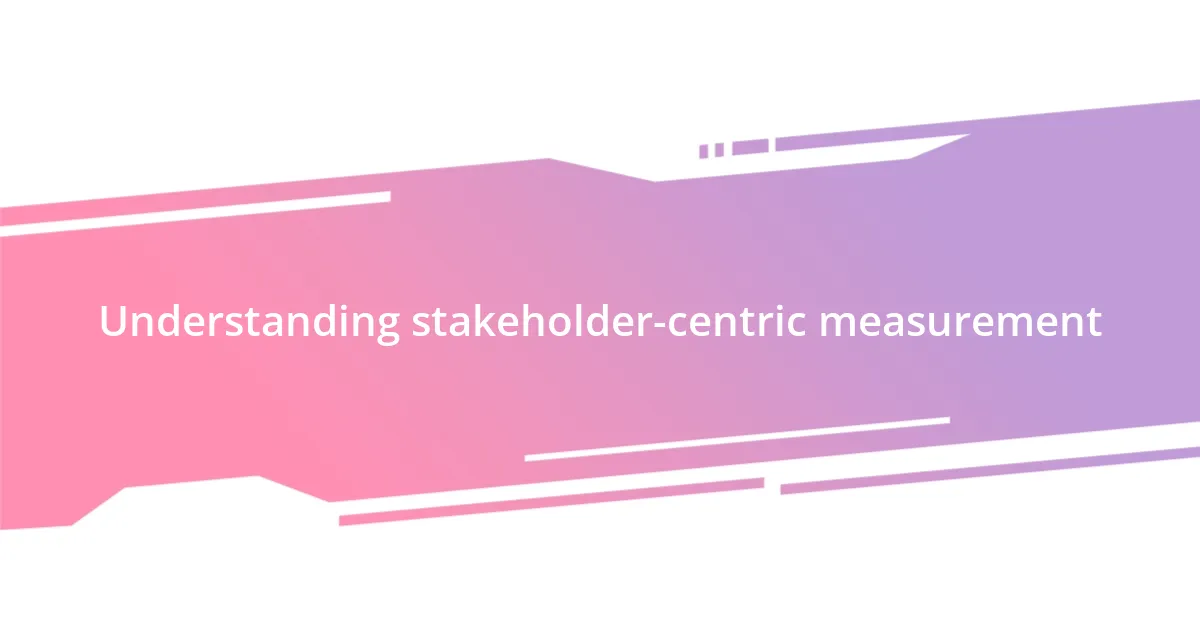
Understanding stakeholder-centric measurement
Stakeholder-centric measurement is all about prioritizing the voices and experiences of those most impacted by a project or initiative. I remember working on a community development project where we gathered input from local residents, and it was eye-opening. Their insights shaped our approach, revealing needs we hadn’t considered, like access to mental health resources—not just physical infrastructure.
When engaging with stakeholders, I often ask myself: How can we ensure their perspectives are genuinely heard? It’s crucial to create an environment where stakeholders feel safe sharing their thoughts. I’ve facilitated workshops where people expressed both hopes and concerns. The emotional weight in those conversations was profound; it reminded me that behind every statistic is a real individual, with dreams and struggles.
Understanding these perspectives isn’t just about collecting data; it’s about weaving their stories into the fabric of our measurement strategy. I recall a time when our project’s success was redefined not by the number of houses built but by the sense of community fostered. This shift in focus transformed our evaluation process, making it richer and more meaningful for everyone involved.
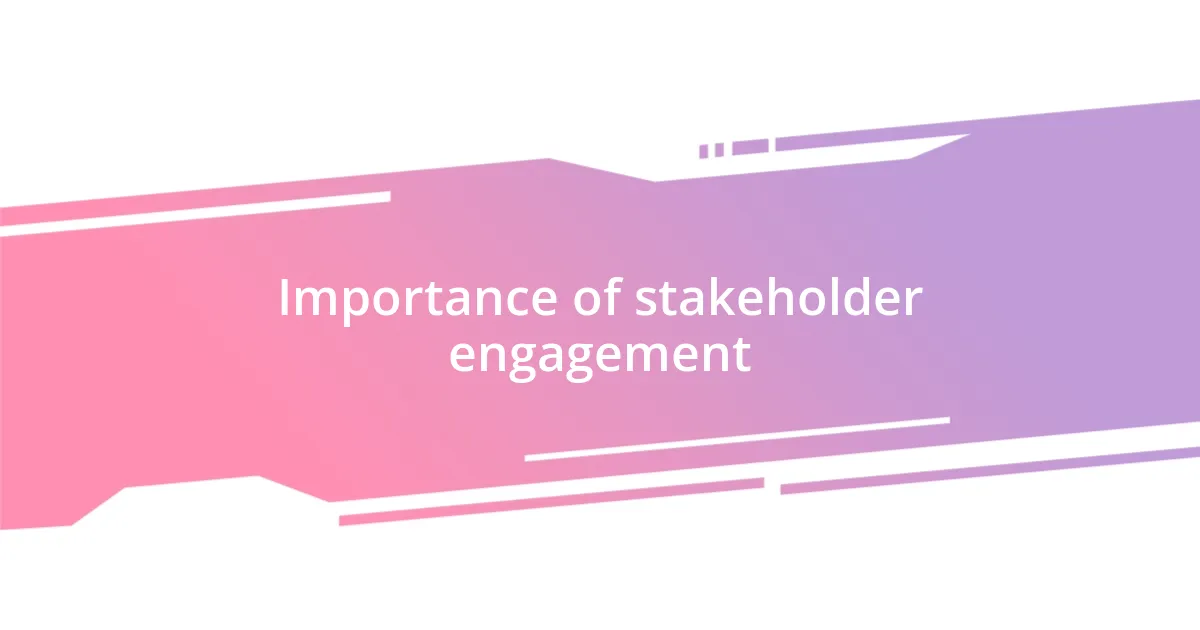
Importance of stakeholder engagement
Engaging stakeholders is pivotal for any successful initiative. I remember a project where we overlooked involving a key local organization, thinking we could manage without them. The result? Misinformed decisions that didn’t reflect community needs. I learned that even one missed voice can skew the entire impact measurement process, underscoring the necessity of comprehensive engagement.
In my experience, stakeholders bring unique perspectives that can completely change the course of a project. Recently, we conducted interviews with a diverse group of community members for a youth outreach initiative. Their stories not only highlighted critical gaps in services but also pointed us towards effective strategies that we hadn’t considered. Listening to their lived experiences made the entire team more empathetic and focused, ultimately leading to a more robust evaluation framework.
I’ve come to appreciate that stakeholder engagement fosters trust and ownership among all parties involved. When stakeholders see their input reflected in outcomes, they become more invested in the project’s success. I recall a scenario where a local parent group felt their voices were not just heard but actually valued in our process. Their increased participation led to a remarkable surge in community support, transforming our efforts from a top-down approach to a collaborative endeavor. Such engagement is not just beneficial; it’s foundational.
| Aspect | Without Stakeholder Engagement | |
|---|---|---|
| With Stakeholder Engagement | Community insights are ignored, leading to potential misalignment with real needs. | |
| Decision-making | Informed primarily by project leaders, may miss critical local knowledge. | |
| Emotional investment | Minimal connection to the community. | Creates a sense of ownership and fosters trust among stakeholders. |
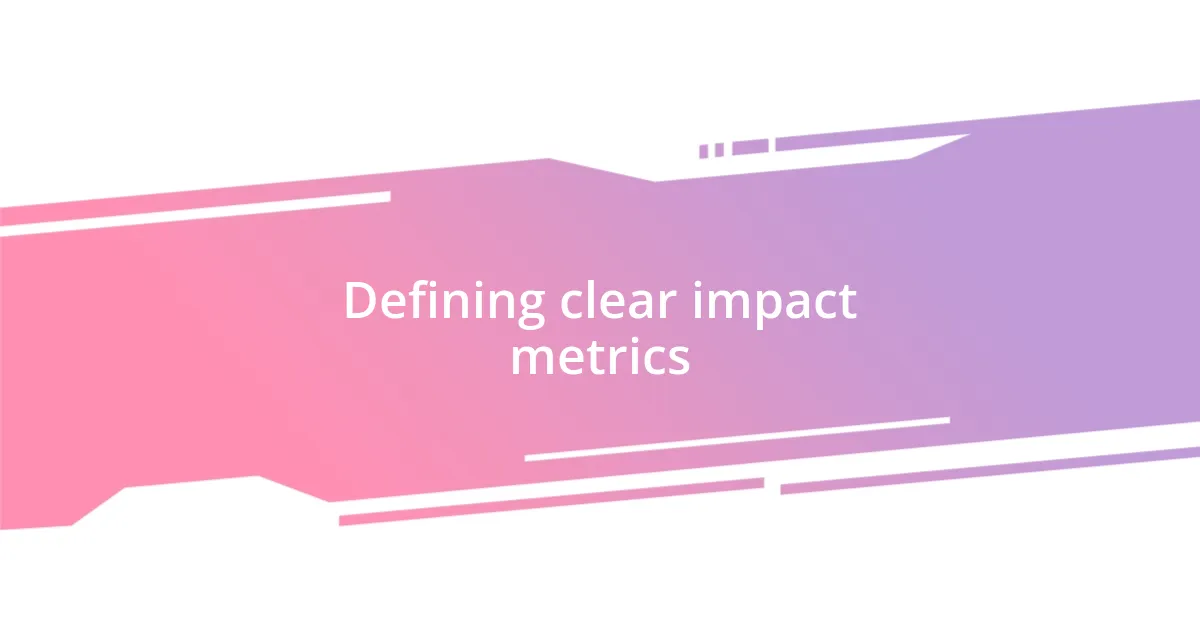
Defining clear impact metrics
Defining clear impact metrics requires a thoughtful approach that reflects the true needs and aspirations of stakeholders. I remember leading a project that aimed to improve educational outcomes for at-risk youth. We initially set broad metrics, like test scores and graduation rates, but after in-depth discussions with educators and students, it became clear that factors such as emotional well-being and engagement in learning were equally crucial. This realization led us to create a more nuanced set of impact metrics that accounted for both academic and social dimensions.
I believe that defining these metrics should be a collaborative process. Here are some key elements to consider when developing clear impact metrics:
- Stakeholder Input: Incorporate feedback directly from those affected to ensure metrics are relevant.
- Measurable Outcomes: Specify what success looks like in quantifiable terms to monitor progress accurately.
- Qualitative Insights: Blend quantitative data with personal anecdotes to capture the complete narrative behind the numbers.
- Adaptability: Ensure metrics are flexible enough to evolve as stakeholder needs and project goals change.
- Emotional Context: Recognize the emotional elements contributing to success; metrics should reflect this to foster deeper engagement.
Taking the time to refine impact metrics not only enhances the evaluation process but also strengthens relationships with stakeholders. Through my experience, I’ve found that clarity in metrics ultimately drives shared understanding and collective progress in our initiatives.

Data collection methods for stakeholders
When it comes to data collection methods for stakeholders, I find that employing a mix of qualitative and quantitative approaches yields the best results. Surveys can provide invaluable numerical insights, but I’ve often found that the real gems come from focus groups or one-on-one conversations. In a recent project, our team organized a series of informal chats with community leaders. The stories they shared revealed underlying issues that surveys just couldn’t capture, transforming our understanding of their needs.
Another powerful method is participatory observation, where I immerse myself in the community. I vividly recall attending a local event related to our initiative, simply observing interactions and listening to conversations. This hands-on approach allowed me to witness firsthand the dynamics at play. It brought to light not just what was said but how the community felt about our efforts. How often do we consider emotions and interactions as data? I believe they are just as critical as any statistic.
Finally, tools like digital feedback platforms can simplify the process of collecting ongoing stakeholder input. For instance, we implemented a mobile app that allowed users to provide real-time feedback about our project’s impact. This approach not only made it easier to gather data but also empowered stakeholders to feel like active contributors. Seeing them engage so enthusiastically reminded me of the importance of making the data collection process accessible. It’s about creating channels where every voice can resonate.
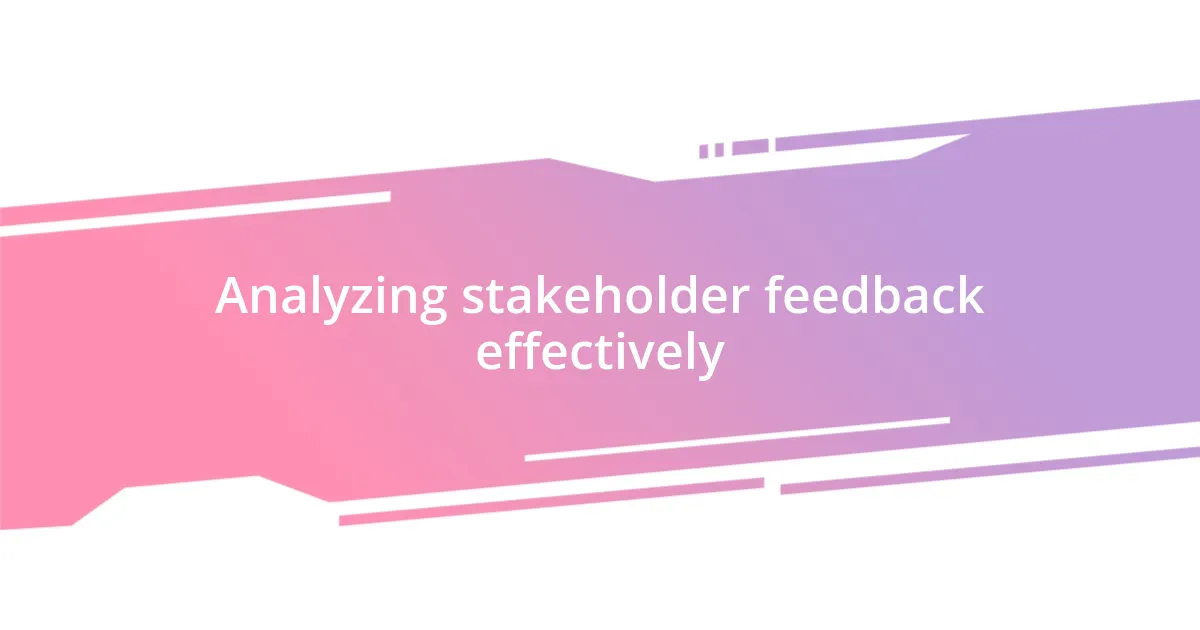
Analyzing stakeholder feedback effectively
Analyzing stakeholder feedback effectively is essential for measuring impact accurately. I often dive deep into the feedback we gather, looking for patterns and themes that extend beyond surface-level insights. For example, during a recent project aimed at enhancing mental health services, I spent hours sifting through client and caregiver interviews. It struck me how consistently they brought up feelings of isolation. This wasn’t just feedback; it was a clarion call for us to rethink our outreach strategies.
I can’t stress enough how important it is to approach this analysis with an open mind. Sometimes, the comments that stand out may not align with initial assumptions. Reflecting on my experience, there was a specific instance where stakeholders expressed concerns about a program’s accessibility, which we had deemed successful. Rather than dismissing their feedback, we convened additional discussions and found that geographical barriers were impacting participation significantly. This adjustment not only enhanced our outreach but also fostered a deeper trust with our stakeholders, as they saw we valued their input.
Finally, it’s vital to triangulate feedback from multiple sources to get a comprehensive view. If a particular theme arises in surveys, focus groups, and direct conversations, it’s probably significant. I remember one project where we assessed feedback from both teachers and students regarding a new curriculum. While teachers noted improvements in performance, students felt the material was disengaging and challenging. This discrepancy fueled a productive dialogue that led us to adapt the curriculum to better suit the students’ needs, ultimately bridging the gap between instructor expectations and learner experiences. Isn’t it fascinating how stakeholder feedback can pave the way for deeper understanding and better solutions?
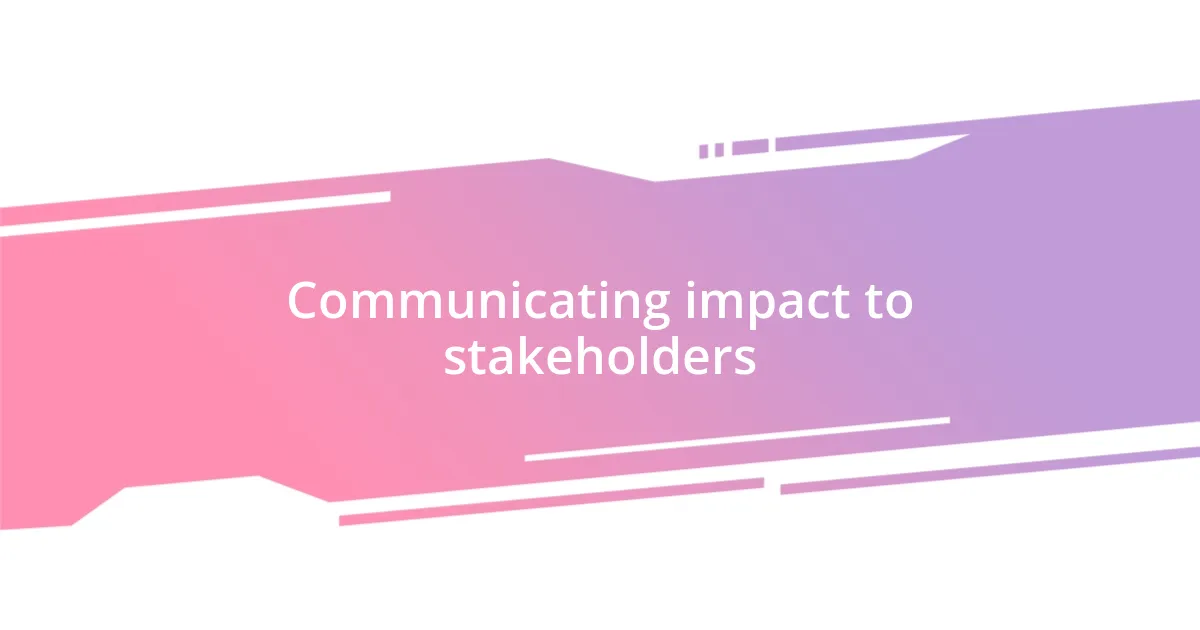
Communicating impact to stakeholders
Communicating impact to stakeholders is an art that blends clarity with emotional resonance. I vividly remember presenting outcomes from a community health initiative to a full room of stakeholders, some looking hopeful and others skeptical. Rather than inundating them with jargon, I chose to share a heartfelt story about a young mother whose life transformed due to our program. This approach not only conveyed the impact in measurable terms but also struck a chord, turning numbers into relatable experiences. Have you ever seen how a single story can shift perception?
Transparency plays a crucial role in this communication process. For instance, when we faced challenges midway through a project, I made a choice to share both setbacks and successes with our stakeholders. I distinctly recall a meeting where I laid out our struggles with funding and timeline shifts. The openness fostered trust, and several stakeholders even offered resources and ideas to help overcome those hurdles. It was a moment that reinforced my belief: vulnerability in communication can lead to stronger alliances and collaborative problem-solving.
Moreover, visuals can enhance understanding and retention. One time, I created an infographic that illustrated our project’s progress alongside testimonials from beneficiaries. As I shared it during a stakeholder meeting, I noticed the shift in energy; people leaned in, intrigued by the visuals and stories that encapsulated our journey. Don’t you find that a well-crafted visual can illuminate a narrative in ways words alone sometimes can’t? Engaging stakeholders through thoughtful communication fosters a deeper connection, anchoring them in the project’s impact and future.
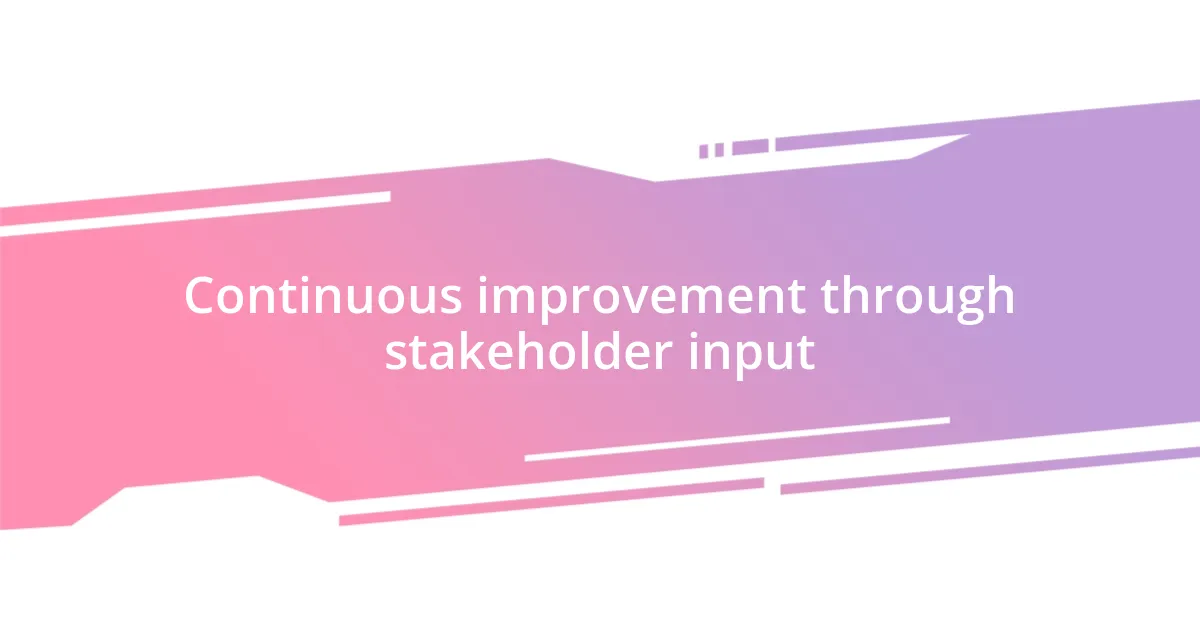
Continuous improvement through stakeholder input
When it comes to continuous improvement, I’ve seen firsthand how crucial it is to incorporate stakeholder input. In one instance, after receiving feedback on a sustainability initiative, I organized a roundtable discussion with community members. Their insights were enlightening; they shared practical ideas that we hadn’t considered, which ultimately shaped our approach and enhanced the program’s effectiveness. Isn’t it remarkable how a simple conversation can lead to significant enhancements?
I’ve also found value in fostering ongoing relationships with stakeholders. For example, in a recent project on affordable housing, I established a feedback loop that allowed residents to share their experiences regularly. This empowered them and created a sense of ownership over the process. By genuinely valuing their input, we not only improved our designs but also reinforced a collaborative atmosphere. How often do we overlook the power of regular engagement in shaping successful outcomes?
Lastly, I believe in celebrating the improvements made through stakeholder feedback. After implementing changes based on community suggestions, we hosted an informal gathering to share the progress. Witnessing the joy on stakeholders’ faces as they saw their ideas come to life was incredibly rewarding. This not only strengthened our relationships but also encouraged continued dialogue, ensuring we’re always moving forward. Have you ever experienced that joy of collaboration? It’s a feeling that keeps pushing us to do better together.

